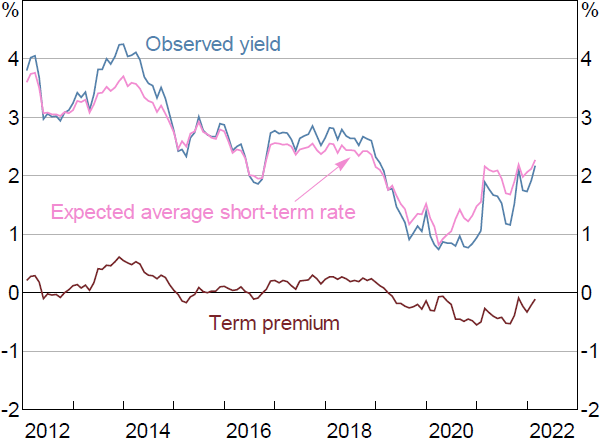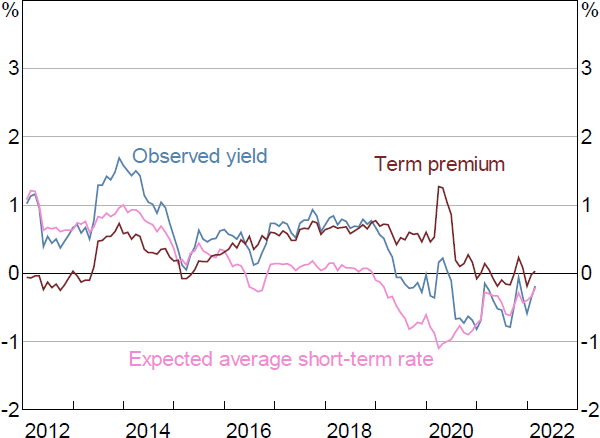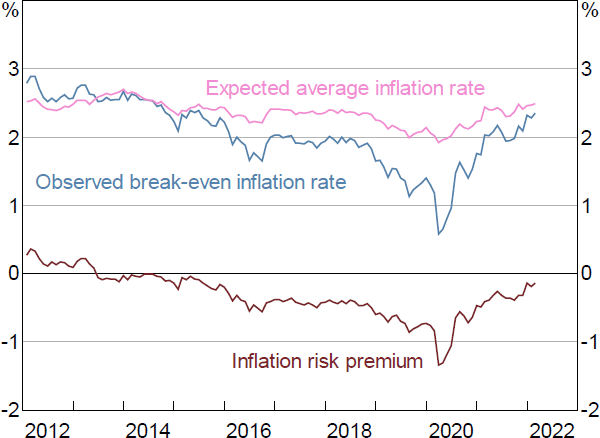RDP 2022-02: The Yield and Market Function Effects of the Reserve Bank of Australia's Bond Purchases 6. Expected Future Short-term Rates and Term Premia
May 2022
- Download the Paper 1.89MB
So far we have focused on estimating the effect of the Reserve Bank's bond purchases on the overall level of government bond yields. Bond yields can also be thought of as having two distinct components: the average short-term interest rate that is expected to prevail over the life of the bond (i.e. the expected return from investing in a series of short-term government notes over the coming ten years); and the term premium that investors demand for holding a long-term bond rather than investing in a series of shorter-term investments. Changes in expectations for future short-term interest rates give information on bond investors' expectations of policy rates over coming years, while changes in term premia give information on the levels of interest rate risk and inflation risk that investors perceive, among other things, as well as their attitudes to these risks. We would expect a bond purchase program to push down on term premia via the portfolio rebalancing channel, while the effect on investors' expectations for future short-term interest rates is less clear: future short-term rate expectations could be lowered via the signalling channel if bond purchases were taken as a signal that policy rates would be held lower for longer than previously expected; or future short-term rate expectations could actually increase if bond purchases now were seen as supporting the economy and bringing forward the day when a higher policy rate was needed.
One cannot observe expected future short-term rates or term premia directly by looking at bond yields, since bond yields reflect the combination of both. One can, however, estimate these quantities using a model. A model that is often used for this purpose is a so-called affine term structure model, which assumes that expectations and term premia (and therefore yields) are driven by a few unobserved factors. By estimating those factors, and the model parameters, one can recover estimates of expectations and term premia. It is important to note, however, that a number of assumptions must be made to estimate an affine term structure model, some of which may not hold, and so model outputs should be taken as indicative only.
We use the model of Hambur and Finlay (2018) to estimate expected future short-term interest rates and term premia.[29] Figure 16 shows that the 10-year nominal bond yield fell over the first few months of 2020 and reached a low in March of that year, as fears around the health and economic impact of COVID-19 grew. The 10-year yield stayed in a relatively narrow range over the remainder of 2020, before increasing in early 2021 alongside increasing optimism regarding the economic outlook. Underlying these movements, however, are divergent trends in estimates of expectations for future short-term rates and term premia. In particular, the onset of the crisis saw expectations of average future short-term rates fall substantially, before rebounding in early 2021. The term premium, in contrast, rose as the crisis intensified, but then fell over the remainder of 2020. These outcomes align with what might have been expected: as the crisis intensified, investors began to expect that the Reserve Bank would hold policy rates low for many years into the future. At the same time, the amount of risk in the economy was clearly increasing, and investors' desire to bear that risk was declining, leading to higher term premia. But as governments and central banks responded to the crisis, and as effective vaccines were developed, investors became more optimistic about future prospects and so raised their expectations for average future short-term interest rates. At the same time the Reserve Bank undertook substantial purchases of government bonds, the perceived riskiness of holding bonds fell, and investors' appetite to bear risk increased, pushing down on term premia.[30]

One can decompose the three nominal time series presented in Figure 16 further, with each composed of a real component and an inflation-compensation component. That is, expectations for average future nominal short-term rates can be thought of as comprising expectations for average future real (i.e. inflation-adjusted) short-term rates plus expectations for average future inflation, and similarly for term premia. These decompositions are shown in Figures 17 and 18, and suggest that the fall and then increase in nominal short-term interest rate expectations was largely driven by moves in real rate expectations, which were likely to have been related to lower real growth expectations initially, which then recovered. Meanwhile, changes in inflation expectations were similar in direction but more muted. It was also a sharp move higher in real term premia in early 2020 that drove nominal term premia higher, while the inflation risk premium initially fell as the perceived probability of high future inflation declined.[31] Higher real term premia reflected uncertainty around future real interest rates, in turn driven by uncertainty around economic growth, while lower inflation risk premia reflected less concern around the risk of high future inflation.[32] These moves were then reversed over the rest of 2020 and into 2021.


Footnotes
The model separates expectations from term premia using the time-series properties of the estimated factors (which are assumed to evolve according to the distribution under which expectations are formed) and also survey data on economists' cash rate and inflation expectations (which do not contain term premia). [29]
Term premia are also estimated to have been quite low (and sometimes negative) in the years preceding the pandemic, and earlier bond purchase programs by other central banks are likely to have contributed to this. [30]
Part of the fall in our estimate of the inflation risk premium (and part of its subsequent reversal, at least initially) is better attributed to the deterioration (and subsequent recovery) in the function of government bond markets, the prices of which underpin our estimate. However, the continued increase in the inflation risk premium from the second half of 2020 is less attributable to this, because by that time government bond markets were again functioning fairly well. [31]
Movements in the equivalent 3-year rates and premia are qualitatively similar, although the nominal 3-year term premium rose more sharply over 2021, driven mainly by a move higher in the inflation risk premium; the expected 3-year real rate was more negative over 2020 and 2021 at around –1½ per cent; and the increase in expected inflation from the low in March 2020 was more pronounced. [32]